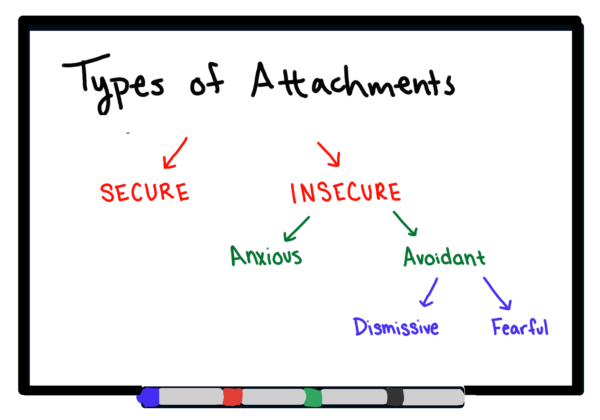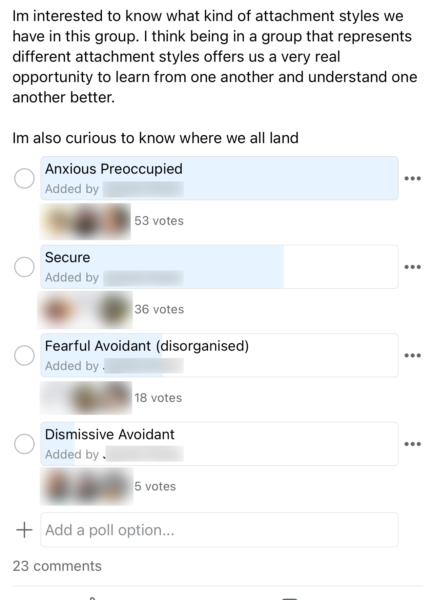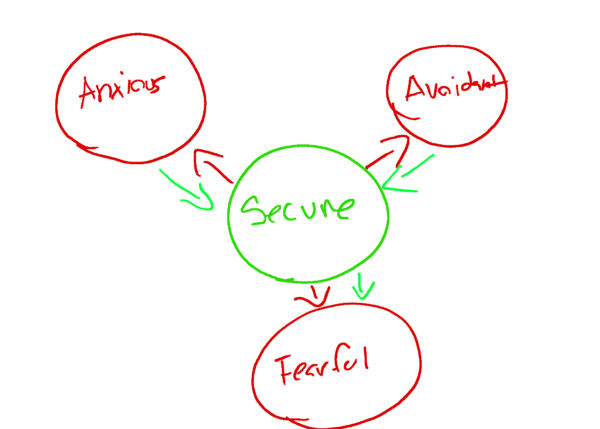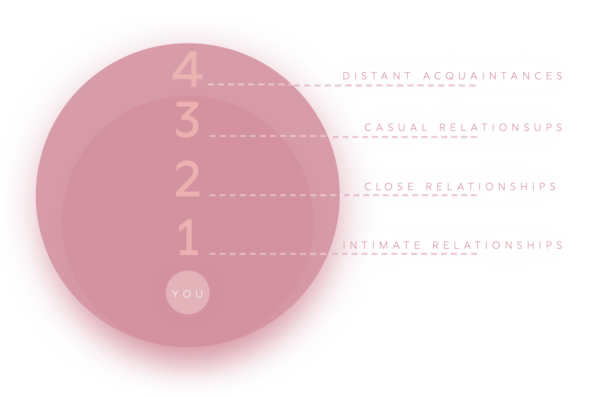Today we’re going to talk about how you can overcome an anxious attachment style specifically relating to a breakup.
My team and I have noticed that extreme moments of trauma (as experienced during a breakup) tend to be a pretty basic “trigger point” for the anxious individual to become, well, more anxious.
So, the main goal of this article is to give you a basic understanding on what needs to be done to have a more secure attachment style.
In all, I’d like to cover the following things
- Define The Anxious Attachment Style
- Introduce The Secure Attachment Gravity Component
- Healthy Relationships Beget Healthy Attachment Styles
Let’s begin!

What Are Your Chances of Getting Your Ex Boyfriend Back?
Take the quizDefining Anxious Attachment Style
Ok, so really there are two types of attachment style categories.
- The secure attachment styles
- The insecure attachment styles
Within the “insecure attachment categories” there are three subsets of insecure attachments.
- Anxious attachments
- Avoidant attachments
- Fearful attachments
This graphic pretty much explains the whole flow chart,
Now, we are specifically focusing on the anxious attachment style today because the majority of the visitors to this website, by their own admission, have an anxious attachment style.
I believe the math on it is 47%. So, that means close to half of the users of this website are anxious.
But what does that mean?
Someone with an anxious attachment style is someone who deeply cares about their relationships. So much so, that they often wrap their whole identity up into their relationships making them more prone to the following behaviors,
- Jealousy
- Putting up with unacceptable behavior from partners
- Settling
- Being overly helpful in their relationships
- Taking on the majority of blame, guilt, etc when the relationship fails
- Struggle with self esteem
Interestingly, we’ve also correlated a lot of the breakup bad behaviors to this type of attachment style as well. In fact, after a breakup an anxious attachment style is prone to these behaviors,
- Facebook stalking
- Begging for an ex back
- Showing up to an exes house unannounced
- Trying “hail mary” get your ex back attempts
- Obsessing over an ex
Officially, the anxious attachment style is defined as,
Anxious preoccupied attachment is an attachment style in which a person experiences anxiety in their relationships with significant others in their lives. It stems from attachment theory which argues that childhood experiences can affect our relationships later in life. (source)
So, the big question that many of our clients have is how do they overcome their anxious attachment style?
Well, I think the first step is by understanding that healthy relationships beget healthy attachment styles.
Healthy Relationships Beget Healthy Attachment Styles
First things first, what is the major difference between a secure attachment style and an anxious one?
I think looking at how they process breakups can be illuminating.
For example, after a breakup the anxious person will,

What Are Your Chances of Getting Your Ex Boyfriend Back?
Take the quiz- Obsess about what they did wrong (even if they didn’t do anything wrong)
- Immediately try to fix the relationship
- Beg for an ex back
- Stop eating
- Have these negative thoughts that the world is over.
Starting to sound familiar?
Now, on the other hand a secure person has secure habit embedded within their behavior,
- They talk to their loved ones about what they’re feeling
- Write down what they think and feel
- They might try meditation or therapy
- Exercise to relieve stress and increase endorphins
- They practice being aware of their thoughts when they’re emotional
- Remove themselves from an emotional situation if it is becoming uncontrollable
The thing you need to understand about attachment styles is that if you want to “change” your anxious attachment style to being more secure it’s not like you can simply make a choice to do that.
Attachment styles are formed in relationships, maintained in relationships and reformed in relationships. One does not change their attachment style on their own. One CAN engage in self-care and work on redirecting energy back into self. More on that in a minute. One can work on introspection and understanding their attachment style, tendencies and injuries. Healthy relationships beget secure attachment.
This is a concept that you’ll often see me talking about on this website called secure attachment gravity.
Essentially the way it works is kind of complicated.
If an insecure attachment gets partnered with a secure attachment then that secure attachment can actually act as gravity and begin to “lead by example.”
Usually this is how an anxious person can become more secure. They’ll learn through others. But it’s actually even more complicated than that.
You are familiar with tug of war, right? Well, any time a new relationship is formed with someone a kind of tug of war occurs with regards to attachment style.
Let’s use an example.
For a moment pretend that you have an anxious attachment style and I have a secure one. The two of us decide to date. From an attachment perspective the tug of war begins and only one person can win.
- Either my secure tendencies can win out and your anxious tendencies can slowly but surely become more secure
- Or your anxious tendencies can win out and my secure tendencies can slowly become more insecure
Gravity can work both ways,
This is often why you see people change in relationships. It’s because one attachment style is dominating the other.
But for our purposes this is super helpful because weirdly the best place to start “improving” your anxious tendencies is by focusing on your sphere of influence.
The Sphere Of Influence
Last week I wrote an article called “What To Do With Your Life After A Breakup” and I make a case that everyone has the right to be selfish when it comes to the people they surround themselves with.
In fact, I cited a line from Billions (which is kind of ironic because the character I cited it from is definitely not “secure”) but I believe there is a lot of truth to the line,
“I don’t hold on to a loser. The moment it doesn’t feel right I let it go and get away from it.”
All of us can stand to be a little more selfish about the people we surround ourselves with. More on this in a minute.
First things first, the sphere of influence, what is it?
Simply put, the sphere of influence is an idea revolving around the people you surround yourself with. People tend to be swayed by the opinions of their sphere of influence and it makes a huge difference in the “ex back scene” but that’s neither here nor there.

What Are Your Chances of Getting Your Ex Boyfriend Back?
Take the quizThe closer you are to the “you” circle in that graphic the more your opinion matters. The farther away you are, the less.
My argument is simple. I think everyone who has an anxious attachment style needs to start rounding their sphere of influence out with secure individuals.
Harkening back to my billions argument,
“I don’t hold on to a loser. The moment it doesn’t feel right I let it go and get away from it.”
But Chris…. my best friend is incredibly anxious do I have to kick him/her out?
Well, yes.
Be methodical about it. This is your life we are talking about here. Do you think I surround myself with anxious people? No, I cut them out.
My rule is simple, if you aren’t adding anything to benefit my life then I don’t want you around. Now, not to seem too selfish, that’s not what friendship or companionship is. You have to give them something in return. I’ll talk about how to do that in a minute but I want to talk about another thing I’ve noticed.
When it comes to friendships I have noticed there are three types of people.
- Givers
- Takers
- Equalizers
Here’s a little tidbit on each,
- The givers give too much of themselves in relationships (Anxious)
- The takers take too much for themselves in relationships (Avoidants)
- The equalizers both give and take in relationships creating fairness (Secure)
Most of the time the givers are the anxious people and the takers are the avoidant ones. How do you tell which one of these your friends are?
Simply pay attention to the topic of conversation.
Takers will usually only talk about themselves.
Givers won’t talk about themselves at all.
What you are looking for is to surround yourself with secure individuals, people who talk about you and themselves equally.
Individuals who process and regulate emotions in a positive way.
So, here’s my challenge for you.
Cultivate a remarkable sphere of influence. One that can help actually show you the way to a secure attachment and you’ll find that you yourself will probably start to become more secure.



